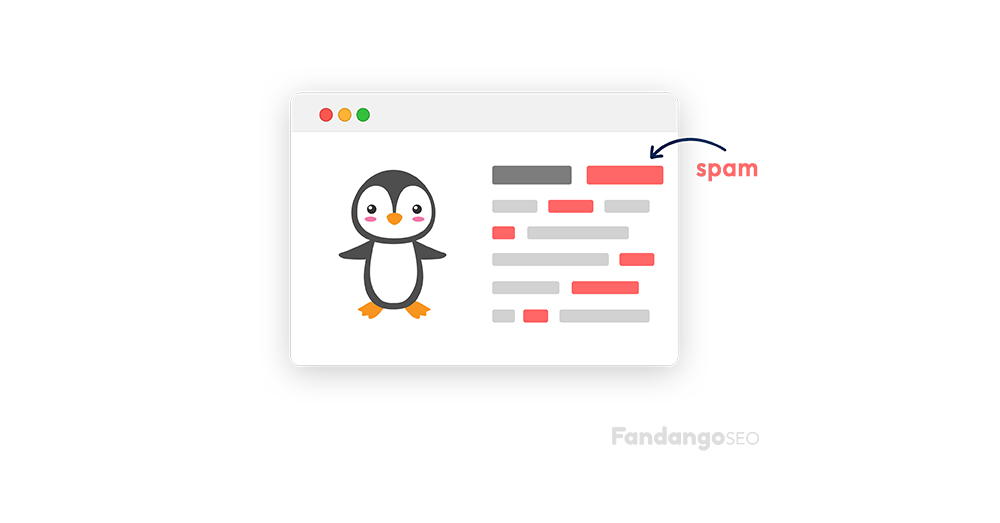What is Google Penguin?
It’s a cryptonym for a Google algorithm update announced for the first time on 24 April 2012. The Google update aims to lower search engine rankings of sites that violate the Webmaster Guidelines of Google. It was designed for techniques called black-hat SEO involved in increasing artificially a webpage ranking by trying to manipulate the number of links that are pointing to the page. These tactics are commonly called link schemes. Google has announced all Penguin filter updates to the public, according to Google staffer John Mueller.

Google Penguin 4.0
On 23 September 2016, Google announced that Google Penguin had become part of its core algorithm, updating it in real-time. Therefore, Google will no longer make announcements that relate to future refreshes. Also, real-time means that they evaluate sites in real-time plus rankings are impacted in real-time as well.
During the last years, Google’s webmasters instead had to always wait for the next update roll-out to escape a Penguin penalty. Google Penguin 4.0 is also more granular than the previous updates, because it may affect a whole site on the basis of URL as opposed to affecting a whole site.
Also, Penguin 4.0 is different from the previous Penguin versions because it doesn’t demote a site if it finds bad links: it discounts the links instead. That means that it ignores them, and the websites no longer count towards ranking.
As a result, there is less need to use the disavow file since Google uses both human reviewers and algorithms to identify artificial (unnatural) links, deceptive or manipulative. It includes these in its websites’ Manual Actions report. Although links are still highly relevant for ranking, bots don’t treat all links similarly. Therefore, and link quality has gained importance after this update.
What are the Triggers for Penguin?
Penguin aimed at two specific practices:
• Keyword Stuffing
This is populating a page with repetitions of keywords or a large number of keywords. The goal is to manipulate rank through the appearance of importance to specific search phrases.
• Link Schemes
It is the purchase, acquisition, or development of backlinks from unrelated or low-quality sites. For instance, a company could decide to fill the internet with spam comments that link to itself, showing that it’s the best company. A company might also pay to have links stating they are the best, and the links appear on an unrelated 3rd party article concerning a different topic. This practice leads to an unnatural picture of relevance and popularity to manipulate Google into giving high rankings.
How Can I discover if I Penguin has hit my site?
First, it is essential to recognize the difference between a manual penalty for artificial linking and Penguin. In short, Penguin is typically a Google index filter that applies to all sites. In contrast, a manual penalty is always specific to a single site that Google has determined to be spamming. The manual penalties may be due to a site being reported for spam by Google users. Also, it is speculated that Google can manually monitor some industries (such as payday loan companies) more cthan others (such as cupcake bakeries).
If analytics on your website shows a ranking or traffic drop on dates where there was the Penguin update, it has probably hit you. Ensure you have ruled out traffic fluctuations expected from phenomena such as seasonality (for example, Christmas tree farms in April). Also, thoroughly evaluate whether your linking practices or keyword optimization could be considered spammy by Google. This can make your website vulnerable to an update such as Penguin.
How Can I Recover from Penguin?
With a manual link penalty, you have to file a request for reconsideration with Google once you have cleaned the house. You don’t file such a request when you want Google to lift a Penguin penalty. Instead, when you take action to remedy problems, it will typically earn you ‘forgiveness’ the next time that Googlebot comes crawling to your website.
These recovery steps include the following:
• The removal of any unnatural links over which you’ve controlled. This includes links you have built yourself or links you have managed to put on third-party sites
• Spammy links disavowal that you cannot control
• Revision of the content of your website to remedy over-optimization. Make sure that keywords have been naturally implemented rather than robotically, nonsensically, or repetitively on web pages where there’s no relationship between the keywords used and the topic.
Google created Penguin to solve a critical weakness of its system. Until then, the algorithm could be tricked by a large number of low-quality links, as well as with the over-optimization of keywords of web pages. Avoid Google from devaluating your site because of spam practices. Always publish content that reflects natural language. Also, your link-earning-and-building should be considered “safe.”
Google Panda Google Page Rank
